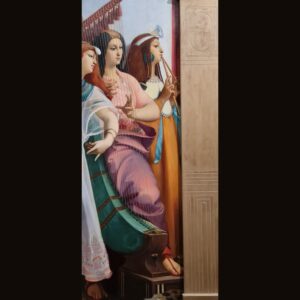Here is a çeng that appears in French painter Jean Lecomte du Noüy’s imagination of a harem. Painted somewhere between 1885-1886, the painting, a tryptic of oil on canvas shows cleary a çeng such as the ones played in Ottoman courts of probably earlier times since çengs had dissappeared as early as the beginning of 17th century. Referring to Ramses’ harem, the painting pays hommage to the ancestry of Mesopotamian harps which were common in the medieval courts of the Near-East. Çengs which have their soundboards in the uppermost part as opposed to European harps are held with the soundboard up. Here, however, the painting shows a large çeng, held like European harps, resting on a small platform.
Fransız ressam Jean Lecomte du Noüy’ün harem tasavvurunda yer alan bir çeng. 1885-1886 yılları arasında yapılmış olan tuval üzerine yağlıboya bir triptik olan tablo, 17. yüzyılın başlarında çengler ortadan kaybolduğu için muhtemelen daha eski zamanlarda Osmanlı sarayında çalınanlara benzer bir çengi açıkça göstermektedir. Ramses’in haremine atıfta bulunan resim, Yakındoğu’nun Ortaçağ saraylarında yaygın olan çengin Mezopotamya’daki atalarına saygı duruşunda bulunuyor gibi. Avrupa arplarının aksine gövdeleri üst kısımda yer alan çengler, gövde yukarıda olacak şekilde tutulur. Ancak bu resim, Avrupa arpları gibi tutulan büyük bir çengi küçük bir platform desteğiyle sabitlenmiş olarak göstermektedir.


